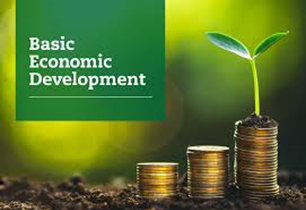
It is well recognized that economic growth is a phenomenon of market productivity and increase in GDP, whereas economic development is regarded as a policy intervention aiming at improving the well-being of people. In simple terms, economic growth is one aspect of economic development.
Seeking viable information on how economic growth can be secured, The Ethiopian Herald had a stay with Mekonnen Telila, an economist graduated from Dilla University. He said, “Economic growth refers to an increase in aggregate production in an economy, which is generally manifested in a rise in national income. Often, but not necessarily, aggregate gains in production correlate with increased average marginal productivity. That leads to an increase in incomes, inspiring consumers to open up their wallets and buy more, which means a higher material quality of life and standard of living.”
He said, in economics, growth is commonly modeled as a function of physical capital, human capital, labor force, and technology. Simply put, increasing the quantity or quality of the working age population, the tools that they have to work with, and the recipes that they have available to combine labor, capital, and raw materials, will lead to increased economic output.
As to him, economic growth is the most powerful instrument for reducing poverty and improving the quality of life in developing countries like ours. Strong growth and employment opportunities improve incentives for parents to invest in their children’s education by sending them to school. This may lead to the emergence of a strong and growing group of entrepreneurs, which should generate pressure for improved governance.
He said, “Strong economic growth can advance human development, which, in turn, promotes economic growth. But under different conditions, similar rates of growth can have very different effects on poverty, the employment prospects of the poor and broader indicators of human development. A successful strategy of poverty reduction must have at its core measures to promote rapid and sustained economic growth.
The challenge for policy is to combine growth promoting policies with policies that allow the poor to participate fully in the opportunities unleashed and so contribute to that growth. New technologies offer not only ‘catch-up’ potential but also ‘leapfrogging’ possibilities. New science offers better prospects across both productive and service sectors.
Future growth will also need to be environmentally sustainable. Improved management of water and other natural resources is required, together with movement towards low carbon technologies by both developed and developing countries. With the proper institutions, growth and environmental sustainability may be seen as complements, not substitutes. But ultimately the biggest determinants of growth in a country will be its leadership, policies and institutions.
According to Mekonnen, the positive link between growth and poverty reduction is clear. The impact of the distribution of income on this relationship – in particular, whether higher inequality lessens the reduction in poverty generated by growth – is less clear. Initial levels of income inequality are important in determining how powerful an effect growth has in reducing poverty.
Growth creates jobs and economic growth generates job opportunities and hence stronger demand for labor, the main and often the sole asset of the poor.
In turn, increasing employment has been crucial in delivering higher growth. Macroeconomic factors, such as low inflation, export orientation and low labor taxes, help to determine how much employment is created by growth. Structural factors, such as the balance of the economy between agriculture, manufacturing and services, are also important. While the relationship between growth and employment remains robustly positive, the strength of the link has weakened slightly since the turn of the millennium. This has raised concerns about ‘jobless growth’ in some countries.
“The relationship between growth and employment is not simply about the quantity of jobs created by growth; it is also about the types of jobs created. In particular, there have been concerns that the number of jobs in the informal freelance sectors rises with growth alongside increases in the formal sector. While informal employment is better than none at all, it has been assumed that it is very much second best to formal employment. The combination of excessively regulated labor markets and low levels of development is the principal driver of the informal sector. Careful deregulation of labor markets will reduce the cost of employment for firms in the formal sector and increase the share of formal employment,” he opined.
Growth drives human development and economic growth is not just associated with reducing poverty. There is also clear evidence for a positive link between economic growth and broader measures of human development. Strong growth and employment opportunities improve incentives for families to invest in education by sending their children to school. This may lead to the emergence of a strong and growing group of entrepreneurs, which will generate pressure for improved governance. Strong economic growth therefore advances human development, which, in turn, promotes economic growth. Equally, weak economic growth implies vicious circles in which poor human development contributes to economic decline, leading to further deterioration in human development.
Yes, as to Mekonnen, political instability, corruption and crime can all threaten potential returns and make investment unattractive and thus damage the prospects for growth. The cost of crime and the cost of security as a percentage of sales are particularly high in low-income regions such as sub-Saharan Africa. Infrastructure Investors need good access to knowledge, to inputs of capital, labor and raw materials, and to markets. This requires transport infrastructure, as well as the provision of a regular supply of electricity and other utilities.
In Africa, transport and energy make up the largest proportion of indirect costs for businesses, weighing heavily on the competitiveness of firms in most African countries. In addition to transport infrastructure, communication infrastructure is crucial in disseminating information about prices and markets across a wide area. In this respect, the spread of mobile communications has been revolutionary. In recent years, limited banking services have even become available using mobile telephones in many parts of the developing world.
He said no country has grown on a sustained basis in recent times without successfully integrating into global markets. There are two facets to this: integration into goods markets and integration into input markets, notably integration into financial capital. The relationship between open capital markets and growth is less clear. Capital market integration allows smoothing of living standards, risk-sharing among countries and technology transfer from the developed world. For many African nations, agriculture will be the centerpiece of their efforts to achieve growth, poverty reduction and food security for the foreseeable future.
As to Mekonnen, a key challenge is to make agriculture more worthwhile by raising its profitability through technological innovation. A growth strategy will involve a combination of economic policy initiatives and plans for expenditure on physical and social infrastructure and other growth-related activities.
“These initiatives or strategies should be fully appraised, and decisions based on estimates of likely returns have to be passed. They should be integrated in overall government decision making, recognizing trade-offs between expenditures in different sectors. The strategies should also be integrated with macroeconomic projections thereby giving a view of future income levels, government revenue and expenditures, and external financing requirements both from donors and from capital markets,” he added.
Public, private, educational, and civic partners in each regional state often come together to help their businesses, industries and workers adapt to new economic challenges or opportunities. Some states of the nation benefit from a robust civic infrastructure; others suffer from weakened civic capacity reflecting years of economic disinvestment, that’s why economic development leaders from across the urban and rural continuum, such as in various states have stepped up to create high-quality, entrepreneurial, and inclusive growth in their communities, he opined.
As to him, this kind of inclusive economic development is hard work and even pioneers in the field face many barriers to implementation. Some states have administrators or leaders typically lack the resources and organizational capacity to plan well, coordinate across sectors, and respond to a patchwork of rural, tribal, and place-based programs alongside other state or philanthropic resources.
In sum, it is quite important for the country to lead the national economic development agenda by promoting innovation and competitiveness, preparing regional states for growth and success in the nationwide economy. Hence, it is high time for all Ethiopians to work hard to make a difference. In so doing, endeavoring towards recording economic growth would bear remarkable outcome.
BY MENGESHA AMARE
THE ETHIOPIAN HERALD WEDNESDAY 17 APRIL 2024





